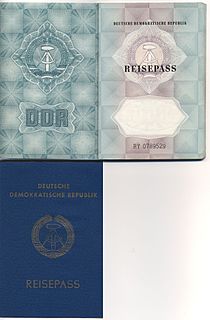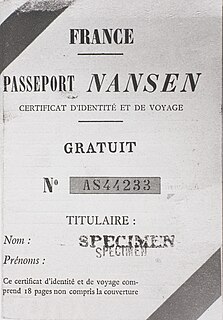 W
WThe British Indian passport was a passport, proof of national status and travel document issued to British subjects of the British Indian Empire, British subjects from other parts of the British Empire, and the subjects of the British protected states in the Indian subcontinent. The title of the state used in the passport was the "Indian Empire", which covered all of India, Pakistan, Bangladesh, and Burma.
 W
WThe Czechoslovak passport was issued to citizens of Czechoslovakia for international travel. After Czechoslovakia split into the Czech Republic and Slovakia, the two countries started issuing their own passports.
 W
WThe East German passport was issued to citizens of the former German Democratic Republic for international travel. Since the reunification of Germany in October 1990, all German citizens have been issued German passports.
 W
WKorean Empire passports were issued to subjects of the Korean Empire for international travel.
 W
WMandatory Palestine passports were travel documents issued by British authorities in Mandatory Palestine to residents between 1925 and 1948. The first brown-covered passport appeared around 1927, following the issue of the Palestinian Citizenship Order, 1925. From 1926 to 1935 alone approximately 70,000 of such travel documents were issued.
 W
WNansen passports, originally and officially stateless persons passports, were internationally recognized refugee travel documents from 1922 to 1938, first issued by the League of Nations to stateless refugees. They quickly became known as "Nansen passports" for their promoter, the Norwegian statesman and polar explorer Fridtjof Nansen.
 W
WRhodesian passports were issued by the government of Rhodesia to its citizens for purposes of international travel. They are no longer issued, having been superseded by Zimbabwean passports in 1980, with the country's reconstitution and renaming as Zimbabwe. Rhodesian passports were ostensibly valid for travel by Rhodesians anywhere in the world, but in practice they were accepted by very few countries.
 W
WThe passport system of the Union of Soviet Socialist Republics was an organisational framework of the single national civil registration system based upon identification documents, and managed in accordance with the laws by ministries and other governmental bodies authorised by the Constitution of the USSR in the sphere of internal affairs.
 W
WThe Soviet passport was an identity document issued pursuant to the laws of the Union of Soviet Socialist Republics (USSR) for citizens of the USSR. For the general purposes of identity certification, Soviet passports contained such data as name, date of birth, gender, place of birth, ethnicity, and citizenship, as well as a photo of the passport holder. At different stages of development of the Soviet passport system, they could also contain information on place of work, social status, and other supporting information needed for those agencies and organizations to which the Soviet citizens used to appeal.
 W
WThe Yugoslav passport was issued to citizens of Yugoslavia for the purpose of international travel. The Yugoslav passport has been described as highly regarded and that with it immigrants were able to find jobs among European firms trading with the East and other countries. It was also described as "one of the most convenient in the world, as it was one of the few with which a person could travel freely through both the East and West" during the Cold War. Passport holders only required visas for six countries: the United States, West Germany, Greece, Israel, Albania and the People's Republic of China.